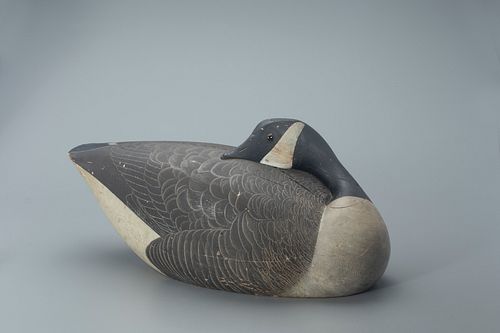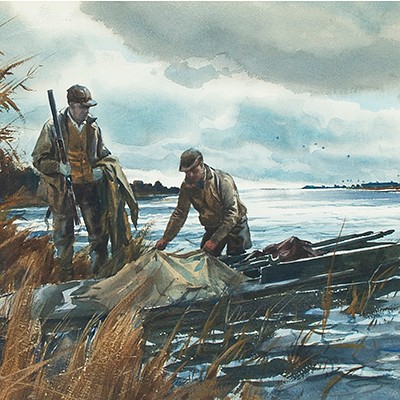Safford Sleeping Canada Goose Decoy, Charles A. Safford (1877-1957)
About Seller
20 Winter Street
Pembroke, MA 02359
United States
Founded in 2005, Copley Fine Art Auctions is a boutique auction house specializing in antique decoys and American, sporting, and wildlife paintings. Over the course of the last two decades, the firm has set auction records for not only individual decoy makers, but also entire carving regions. Copley...Read more
Two ways to bid:
- Leave a max absentee bid and the platform will bid on your behalf up to your maximum bid during the live auction.
- Bid live during the auction and your bids will be submitted real-time to the auctioneer.
Bid Increments
| Price | Bid Increment |
|---|---|
| $0 | $50 |
| $1,000 | $100 |
| $2,500 | $250 |
| $5,000 | $500 |
| $10,000 | $1,000 |
| $25,000 | $2,500 |
| $50,000 | $5,000 |
About Auction
Mar 5, 2022
Lots 265-556 Copley Fine Art Auctions cinnie@copleyart.com
- Lot Description
Safford Sleeping Canada Goose
Charles A. Safford (1877-1957)
Newburyport, MA, c. 1920
37 in. long and 11 in. wide
In "Bird Decoys of North America," independent scholar and curator Robert Shaw expounds on Safford's sleeping goose decoys:
"In recent years, Charles A. Safford (1877–1957) has rightfully been recognized as one of the most talented and imaginative of all American decoy makers. Safford was a multifaceted master craftsman—a highly skilled cabinetmaker and boat builder, a renowned silversmith, a tool maker and leather worker and more—whose skills were sought by many of Newbury’s most prestigious businesses. He was supremely confident in his own abilities; although he was good friends with George Boyd, and undoubtedly appreciated the precision of Boyd’s work, the only real competitor he ever knew was himself.
"But Safford was also a passionate hunter and dedicated observer of wild birds who preferred life in the wild to work in town. So, in the early 1920s, he built a hunting camp on Plum Island, an eight-mile-long barrier beach just south of Newburyport, where he lived year ‘round until 1942. There, he created a visionary rig of oversized geese for his own use. Their bodies and many of the necks were carved from tightly laminated lumberyard boards and the big heavy birds were attached to the corners of flat metal triangles Safford set out in the marsh near his blind, where they remained throughout the hunting season.
"The best known and most celebrated goose from that rig is a sleeper, with its muscular neck and head reaching back and resting on its body. Now, to everyone’s surprise, it turns out that Safford made not one, but two sleepers and the second bird differs from all the other geese in his Plum Island rig in two profound ways. First, its body was carved from a single solid block of wood. Second, the bird’s elaborately detailed and prominent wing and feather paint pattern is unique among Stafford’s full-bodied geese. All the other birds in the rig were painted in muted colors that subtly complemented the carving but drew no attention to themselves.
"Safford rigorously planned every inch of his birds, using precisely measured patterns he sketched around on each side of their bodies before he started carving. While he did not use them on other birds, he also left behind stencils that match the complex paint patterns on the sleeper being offered in this auction. The paint on that bird is old and all by Safford’s hand, exhibiting signs of heavy use. Like its mate, the bird exudes enormous power from a distance, while its integration of subtle carving and highly detailed wing and feather paint rewards the closest scrutiny. The whole decoy is a symphony of interacting lines and fluid curves that keep the viewer’s eye in constant motion.
"Safford also carved decorative miniature decoys. Fifteen of these miniature birds are owned and exhibited by the Museum of Old Newbury, and among them is a sleeping goose, with feather and wing paint virtually identical to this much larger working decoy. He also left behind a flat, life-sized silhouette stick-up field goose that is painted almost identically.
"We will probably never know which came first, the laminated sleeper whose construction and paint conform with the other geese in the rig or the one carved from a single block and painted in such a different style. Both are extraordinary works of sculptural art that transcend their origins as working decoys, and comparing the two can only expand our appreciation for Safford’s genius."
Discussing the lore and legacy of Safford, author and historian Gigi Hopkins writes:
“Although Charles Safford was a member of an old respected family descended from Newburyport’s first English settler, it quickly became evident that as an adult, he had very little use for any restrictions imposed by the proper social life.
"He was schooled locally, proved to be bright and talented, did skilled work with his hands and was drawn to the outdoor life; he was a natural at hunting and shooting. He was small, but wiry and strong, and famous for sculling his sneak float (gunning boat) up-current against the mighty Merrimack River…As a young man, Charlie apprenticed at his great-grandfather’s cabinetmaking shop, Safford and Sons, where he became known for his meticulous craftsmanship...
"Safford had built himself a gunning camp and goose stand at Hale’s Cove on Plum Island, the eight-mile-long barrier beach just south of his hometown. He was now a crack shot, a successful market gunner and a highly sought-after hunting guide. At this point his needs were minimal, and being the gifted craftsman that he was, he could get a job at any firm, including his great-grandfather’s shop or next door at the prestigious Molten Silversmiths. He could create anything in wood from an elegant casket to an elegant seaworthy boat. He worked readily both as a designer and artist in gold and silver (or any other metal). In fact, he quickly mastered any medium to which he turned his attention. He was an inventor as well, employed as a tool maker and machinist when in his forties...
"In the early 1920s, Safford made himself a fine rig of big goose decoys, and designed them to sit three-apiece on flat iron triangles. These spent the hunting season out on the marsh. They were intelligently constructed: the birds’ upright necks were carved from separate blocks that put the grain north-to-south, making them well-nigh unbreakable.
"In 1934, Plum Island, Safford’s home hunting grounds, became a protected bird sanctuary. Happily, Charlie was invited to stay on as the property’s game warden, and he readily accepted the post.
"This change meant that, virtually overnight, Charlie went from gunner to defender of waterfowl. He patrolled his wildlands every day on horseback, or occasionally by car if the weather was foul, and compiled detailed bird lists which Mass Audubon published in its monthly newsletters.
"Eight years on, in 1942, the sanctuary was incorporated into the Parker River National Wildlife Refuge, and Safford, just turned sixty-five, retired and moved down to Lynn, a small coastal city, where he spent the rest of his life with his housekeeper. He kept in touch with his former profession by carving miniature ducks and geese...”
— Special thanks to The Museum of American Bird Art, Mass Audubon, and "Massachusetts Masterpieces" curator and author Gwladys (Gigi) Hopkins for providing this biographical content.
------------------- Along with Captain Charles Osgood's (1820-1886), Nathan Cobb Jr.'s (1825-1905), and A. Elmer Crowell’s (1862-1952) geese, Safford's carvings have found their place as some of America's most iconic ganders. With their exceptional forms and construction, Safford sculptures capture the eye of decoy and folk art collectors alike. Finding any Safford decoy with strong Safford paint is a rarity, as the maker's geese, with their grand size, were designed to spend entire gunning seasons out in the marsh.
Debuting at auction, this decoy has been owned by the same family since it retired from use. It is consigned directly from a North Shore family who discovered it in their hunting cabin, which sits just across the marsh from Safford’s camp. In the cabin were three other important Safford decoys, one of which was featured on the Massachusetts Waterfowl Stamp in 1998. Another bird in this cabin was The Safford Swimming Goose which was sold by Copley in 2019. Lastly, found with this sleeper was a spectacular silhouette decoy with the same distinct feather paint that is seen on this lot.
The revelation of this decoy marks an encore for this now iconic form. In 2009-2010, a flurry of publications celebrated the discovery of the first publicly known Safford sleeping goose after it was acquired in a private sale by Cap and Paige Vinal. The Vinal Safford sleeping goose went on to sell for over $500,000 in 2017.
As a trained cabinet maker, Safford’s construction techniques are enlightening. The grand body was made largely of a single piece of wood, with one board added to a lower edge to fill out the massive form. The sophisticated head and neck were carved with full integrity using several expertly joined blocks of wood. Impressively, Safford chose to inlay blocks of wood in which to set the glass eyes.
This decoy was finished by Safford with the best paint seen on any of his decoys. Indeed, this paint pattern is among the finest seen on any goose decoy, and relates closely to the Harry V. Long Nesting Goose by Elmer Crowell. This elaborate feather paint has only been seen on one other large goose by the maker, the aforementioned silhouette decoy. The surface has developed a desirable dry patina and appealing craquelure.
“It is obvious that Safford enjoyed the process of carving as much as completing the work.” — Gwladys Hopkins, "Decoy Magazine"
“In the flesh this snoozing goose is a drop-to-your-knees bird. It leaps into the pantheon of the greatest American goose decoys ever made, sculpture and function in perfect marriage.” — Gwladys Hopkins discussing the Vinal Safford goose in "Decoy Magazine"
In exceptional Safford gunning paint with even hunting wear. Original fill in crack in the back. A few tight age lines along sides. Wood lamination in head and neck remains tight with slight separation at bill tip.
Provenance: Discovered in a hunting cabin near Safford's camp
Private Collection, Newbury, Massachusetts, by descent in the family from the rig owner
Literature: Robert Shaw, "Bird Decoys of North America," New York, NY, 2010, p. 158, other sleeper illustrated. Gwladys Hopkins, "Massachusetts Masterpieces," Lincoln, MA, 2016, pp. 20-2 and 78-79, other sleeper illustrated and Safford discussed. Jay S. Williamson, "Decoys of the Newburys, Plum Island and Surrounding Communities: Catalog of an Exhibition at the Cushing House Museum," Newburyport, MA, 1999, pp. 41-42, straight-head goose illustrated. Massachusetts Waterfowl Stamp, "Canada Goose by Charles Safford," 1998, rigmate from the same cabin illustrated. Joe Engers, ed., "Year in Review 2017," Decoy Magazine, 2017, front cover and p. 8, other sleeper illustrated. Gwladys Hopkins, "Charles A. Safford and His Canada Goose Decoys," Decoy Magazine, May/June 2009, front cover and pp. 24-29, decoys and miniatures illustrated and discussed.Please email condition report requests to colin@copleyart.com. Any condition statement given is a courtesy to customers, Copley will not be held responsible for any errors or omissions. The absence of a condition statement does not imply that the lot is in perfect condition.Condition
- Shipping Info
-
Copley Fine Art Auctions does not handle the shipping of any items. Shipping is the sole responsibility of the buyer. Once your payment has cleared, and we have received your authorized shipping release form items may be released for shipment. Copley Fine Art Auctions, LLC shall have no liability for any loss or damage to such items. Buyers should allow up to four weeks for shipment.
-



 EUR
EUR CAD
CAD AUD
AUD GBP
GBP MXN
MXN HKD
HKD CNY
CNY MYR
MYR SEK
SEK SGD
SGD CHF
CHF THB
THB






















